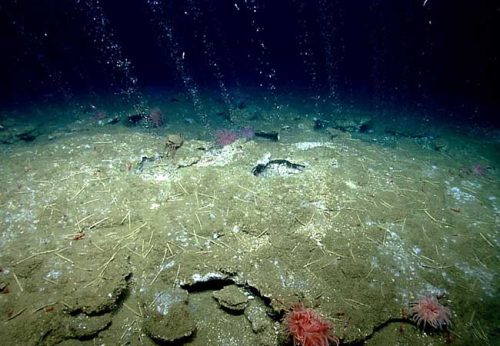Under the ocean floor, there are huge deposits of methane hydrate. The compound is unstable and can release the climate killer methane under certain conditions – such as higher water temperatures. Using a new type of “thermometer”, researchers at Goethe University Frankfurt can measure what the temperature on the sea floor was millions of years ago based on a type of carbonate formed by microorganisms where methane was present. This work might make it possible to answer the question of whether a warming of the oceans in the past led to an increased release of methane.

Methane is a greenhouse gas about 25 times more potent than carbon dioxide. At low temperatures and high pressure, it combines with water to form methane hydrate, an ice-like solid of which huge deposits exist under the seafloor. At least 1,800 gigatonnes of carbon are stored in this form; some estimates even put the figure at more than 20,000 gigatonnes. By comparison, the amount of carbon that mankind has emitted in the form of CO2 from fossil fuel since the beginning of industrialization amounts to 475 gigatonnes.
Methane hydrate is fragile – if the temperature rises, it can break down to methane and water. Methane gas then escapes from the sediment at “methane seeps”. Scientists therefore fear that this methane release could increase due to climate change and thus further fuel the greenhouse effect. It is not yet possible to say for sure how great this danger is. “But perhaps taking a look into the past can provide us with an answer,” explains Jens Fiebig, whose working group conducted the study in cooperation with the University of Hamburg and Shanghai Ocean University.
After all, the Earth experienced longer warm periods in the past, too. However, it is not yet known exactly to which extent the methane hydrate deposits destabilized and what effect this had on outgassing. “This is because the temperature on the ocean floor hundreds of thousands or millions of years ago could not be measured with sufficient accuracy until now, and this temperature could not be directly related to methane flux,” explains Jörn Peckmann from the University of Hamburg. In 2020, however, Fiebig’s research group developed a method that, as has now been shown, might be suitable for this purpose – dual clumped isotope thermometry.
Microorganisms use methane as a source of energy
The methane that outgasses from the deposits is largely consumed by microorganisms. They live in the ocean sediments that cover the methane hydrate deposits, and the gas serves them as a source of energy. The carbon is subsequently mineralized in solid deposits consisting of carbonate. The carbonate minerals contain both carbon and oxygen, which occur in different variants. These are known as isotopes and differ in terms of mass. “Dual clumped isotope thermometry measures the extent to which heavy isotopes group together in the carbonate. This internal arrangement of heavy isotopes within the carbonate allows us both to calculate the temperature at which the mineral forms and to identify the contribution of non-temperature effects,” explains Fiebig’s colleague Dr. Philip Staudigel, who led the research.
“We show that these non-thermal effects contain the ‘fingerprint’ of the microbial community and the methane flux that supported them. Moreover, we were able to correct for this systematic non-thermal effect, which finally allows us to determine more accurately the sediment temperature during the formation of these carbonates,” says Staudigel. He concludes: “Both the temperature and the non-thermal information recorded in the carbonates might be used in the future to reconstruct to which extent heating of the oceans may have led to stronger outgassing.”
Publication: Philip Staudigel, Dong Feng, Jörn Peckmann, Miguel Bernecker, Amelia Davies, Mattia Tagliavento, Jens Fiebig: Resolving and correcting for kinetic biases on methane seep paleotemperature using carbonate ∆47/∆48 analysis. Science Advances (2024) https://doi.org/10.1126/sciadv.adn0155








